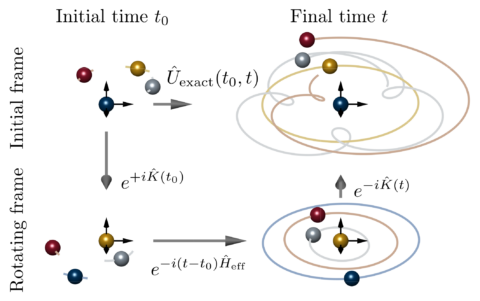Publication in NPJ Quantum Information: “Large-scale simulations of Floquet physics on near-term quantum computers”
In our recent work, by Timo Eckstein, Refik Mansuroglu, Piotr Czarnik, Jian-Xin Zhu, Hartmann Michael, Lukasz Cincio, Andrew Sornborger and Zoë Holmes, that was published just today in Nature Partner Journal Quantum Information, we present an algorithm to simulate periodically time-dependent Hamiltonian dynamics leveraging insights from Floquet theory to be able to re-use tme-independent Hamitlonian simulation algorithms.
Quantum systems subject to a periodic driving field exhibit a diverse set of physical phenomena, including dynamical phase transitions and exotic non-equilibrium topological phases of matter. However, while in many cases more rewarding than their equilibrium counterparts, driven quantum systems are generally more challenging to simulate. In particular, standard Trotterization techniques are limited by significant additional time-dependent error sources; namely a time ordering as well as discrete integration error.
Here, we introduce the Quantum High Frequency Floquet Simulation (QHiFFS) algorithm that sidesteps those time-dependent errors by performing the simulation in a more natural frame of reference. Specifically, we use a high-frequency approximation that performs a time-dependent basis transformation into a rotating frame. This transformation, which can be implemented on quantum hardware using a kick operator, allows one to transform a time-dependent quantum simulation into a time-independent one.
We use the periodically driven biaxial next-nearest neighbor Ising (BNNNI) model, a natural test bed for quantum frustrated magnetism and criticality, as a case study to illustrate our algorithm. We implemented a 20-qubit simulation of the driven two-dimensional BNNNI model on Quantinuum’s trapped ion quantum computer. Our error analysis shows that QHiFFS exhibits not only a cubic advantage in driving frequency ω but also a linear advantage in simulation time t compared to standard Trotterization.
We thank Frédéric Sauvage, Martin Eckstein and Cinthia Huerta Alderete for helpful conversations. We acknowledge support from FAU Erlangen-Nürnberg, Max Planck Institute for the Science of Light, Los Alamos National Laboratory, Jagiellonian University, EPFL, Erlangen National High Performance Computing Center (NHR@FAU), Oak Ridge National Laboratory, Deutsche Forschungsgemeinschaft (DFG) – German Research Foundation (QuCoLiMa), FAU Profile Center Light.Matter.QuantumTechnologies, Bundesministerium für Bildung und Forschung (EQUAHUMO), Munich Quantum Valley, Elite Network of Bavaria, Hightech Agenda Bavaria, U.S. Department of Energy (DOE) (89233218CNA000001), Quantum Science Center, IMPRS Physics of Light, National Science Centre Poland ( 2019/35/B/ST3/01028), and the Sandoz Family Foundation.

